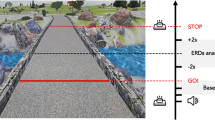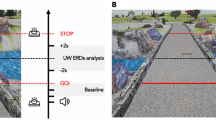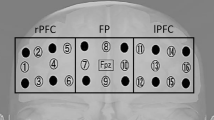Abstract
Imaginary tasks can be used to investigate the neurophysiology of gait. In this study, we explored the cortical control of gait-related imagery in 21 healthy volunteers using functional magnetic resonance imaging. Imaginary tasks included gait initiation, stepping over an obstacle, and gait termination. Subjects watched a video clip that showed an actor in gait motion under an event-related design. We detected activation in the supplementary motor area during major gait-related imagery tasks, and especially during gait initiation. During gait termination and stepping over an obstacle, the amount of cortical resources allocated to the imaginary tasks included a large visuomotor network comprising the dorsal and ventral premotor areas. We conclude that our paradigm to study the cortical control of gait may help in elucidating the pathophysiology of higher-level gait disorders.




Similar content being viewed by others
References
Allison T, Puce A, McCarthy G (2000) Social perception from visual cues: role of the STS region. Trends Cogn Sci 4(7):267–278
Armstrong DM (1988) The supraspinal control of mammalian locomotion. J Physiol 405:1–37
Bakker M, de Lange FP, Stevens JA, Toni I, Bloem BR (2007a) Motor imagery of gait: a quantitative approach. Exp Brain Res 179(3):497–504
Bakker M, Verstappen CC, Bloem BR, Toni I (2007b) Recent advances in functional neuroimaging of gait. J Neural Transm 114(10):1323–1331
Buccino G, Binkofski F, Fink GR, Fadiga L, Fogassi L, Gallese V, Seitz RJ, Zilles K, Rizzolatti G, Freund HJ (2001) Action observation activates premotor and parietal areas in a somatotopic manner: an fMRI study. Eur J Neurosci 13(2):400–404
Coxon JP, Stinear CM, Byblow WD (2009) Stop and go: the neural basis of selective movement prevention. J Cogn Neurosci 21:1193–1203
Cunnington R, Windischberger C, Deecke L, Moser E (2003) The preparation and readiness for voluntary movement: a high-field event-related fMRI study of the Bereitschafts-BOLD response. Neuroimage 20(1):404–412
Debaere F, Wenderoth N, Sunaert S, Van Hecke P, Swinnen SP (2003) Internal vs external generation of movements: differential neural pathways involved in bimanual coordination performed in the presence or absence of augmented visual feedback. Neuroimage 19(3):764–776
Della Sala S, Francescani A, Spinnler H (2002) Gait apraxia after bilateral supplementary motor area lesion. J Neurol Neurosurg Psychiatry 72(1):77–85
do Nascimento OF, Nielsen KD, Voigt M (2005) Influence of directional orientations during gait initiation and stepping on movement-related cortical potentials. Behav Brain Res 161(1):141–154
Genovese C, Lazar N, Nichols T (2002) Thresholding of statistical maps in functional neuroimaging using the false discovery rate. Neuroimage 15(4):870–878
Grezes J, Decety J (2001) Functional anatomy of execution, mental simulation, observation, and verb generation of actions: a meta-analysis. Hum Brain Mapp 12(1):1–19
Grillner S, Wallen P (1985) Central pattern generators for locomotion, with special reference to vertebrates. Annu Rev Neurosci 8:233–261
Hanakawa T, Katsumi Y, Fukuyama H, Honda M, Hayashi T, Kimura J, Shibasaki H (1999) Mechanisms underlying gait disturbance in Parkinson’s disease: a single photon emission computed tomography study. Brain 122(Pt 7):1271–1282
Iseki K, Hanakawa T, Shinozaki J, Nankaku M, Fukuyama H (2008) Neural mechanisms involved in mental imagery and observation of gait. Neuroimage 41(3):1021–1031
Jahn K, Deutschlander A, Stephan T, Strupp M, Wiesmann M, Brandt T (2004) Brain activation patterns during imagined stance and locomotion in functional magnetic resonance imaging. Neuroimage 22(4):1722–1731
Jeannerod M (2001) Neural simulation of action: a unifying mechanism for motor cognition. Neuroimage 14(1 Pt 2):S103–S109
Jeannerod M (2006) Motor cognition: what actions tell to the self. Oxford University Press, Oxford
Jian Y, Winter DA, Ishac MG, Gilchrist L (1993) Trajectory of the body COG and COP during initiation and termination of gait. Gait Posture 1(1):9–22
Lancaster JL, Woldorff MG, Parsons LM, Liotti M, Freitas CS, Rainey L, Kochunov PV, Nickerson D, Mikiten SA, Fox PT (2000) Automated Talairach atlas labels for functional brain mapping. Hum Brain Mapp 10(3):120–131
Leung H-C, Cai W (2007) Common and differential ventrolateral prefrontal activity during inhibition of hand and eye movements. J Neurosci 27(37):9893–9900
MacKay-Lyons M (2002) Central pattern generation of locomotion: a review of the evidence. Phys Ther 82(1):69–83
Malouin F, Richards CL, Jackson PL, Dumas F, Doyon J (2003) Brain activations during motor imagery of locomotor-related tasks: a PET study. Hum Brain Mapp 19(1):47–62
McIntosh RD, McClements KI, Schindler I, Cassidy TP, Birchall D, Milner AD (2004) Avoidance of obstacles in the absence of visual awareness. Proc Biol Sci 271(1534):15–20
Mori S, Matsuyama K, Mori F, Nakajima K (2001) Supraspinal sites that induce locomotion in the vertebrate central nervous system. Adv Neurol 87:25–40
Munzert J, Lorey B, Zentgraf K (2009) Cognitive motor processes: the role of motor imagery in the study of motor representations. Brain Res Rev 60(2):306–326
Nadeau SE (2007) Gait apraxia: further clues to localization. Eur Neurol 58(3):142–145
Nutt JG, Marsden CD, Thompson PD (1993) Human walking and higher-level gait disorders, particularly in the elderly. Neurology 43(2):268–279
Patla AE (2004) Adaptive human locomotion: influence of neural, biological, and mechanical factors on control mechanisms. In: Bronstein AM, Brandt T, Woollacott MH, Nutt JG (eds) Clinical disorders of balance, posture and gait, 2nd edn. Arnold, London, pp 20–38
Penny WD, Holmes AJ (2007) Random effects analysis. In: Friston K, Ashburner J, Kiebel S, Nichols T, Penny W (eds) Statistical parametric mapping: the analysis of functional brain images. Academic Press, London, pp 156–165
Picard N, Strick PL (2001) Imaging the premotor areas. Curr Opin Neurobiol 11(6):663–672
Reynolds RF, Day BL (2005) Visual guidance of the human foot during a step. J Physiol 569(Pt 2):677–684
Rice NJ, McIntosh RD, Schindler I, Mon-Williams M, Demonet JF, Milner AD (2006) Intact automatic avoidance of obstacles in patients with visual form agnosia. Exp Brain Res 174(1):176–188
Rizzolatti G, Craighero L (2004) The mirror-neuron system. Annu Rev Neurosci 27:169–192
Rossignol S, Dubuc R, Gossard JP (2006) Dynamic sensorimotor interactions in locomotion. Physiol Rev 86(1):89–154
Santi A, Servos P, Vatikiotis-Bateson E, Kuratate T, Munhall K (2003) Perceiving biological motion: dissociating visible speech from walking. J Cogn Neurosci 15(6):800–809
Schindler I, Rice NJ, McIntosh RD, Rossetti Y, Vighetto A, Milner AD (2004) Automatic avoidance of obstacles is a dorsal stream function: evidence from optic ataxia. Nat Neurosci 7(7):779–784
Sirigu A, Duhamel JR (2001) Motor and visual imagery as two complementary but neurally dissociable mental processes. J Cogn Neurosci 13(7):910–919
Suzuki M, Miyai I, Ono T, Kubota K (2008) Activities in the frontal cortex and gait performance are modulated by preparation. An fNIRS study. Neuroimage 39(2):600–607
Talairach J, Tournoux P (1988) Co-planar stereotaxic atlas of the human brain: 3-dimensional proportional system: an approach to medical cerebral imaging. Thieme Medical, Stuttgart, 122 p
Thompson PD (2007) Higher level gait disorders. Curr Neurol Neurosci Rep 7(4):290–294
Thompson PD, Nutt JG (2007) Higher level gait disorders. J Neural Transm 114(10):1305–1307
Wang C, Wai Y, Kuo B, Yeh YY, Wang J (2008a) Cortical control of gait in healthy humans: an fMRI study. J Neural Transm 115(8):1149–1158
Wang C, Wai Y, Weng Y, Yu J, Wang J (2008b) The cortical modulation from the external cues during gait observation and imagination. Neurosci Lett 443(3):232–235
Winter D (1995) Human balance and posture control during standing and walking. Gait & Posture 3(4):193–214
Worsley KJ, Marrett S, Neelin P, Vandal AC, Friston KJ, Evans AC (1996) A unified statistical approach for determining significant signals in images of cerebral activation. Human Brain Mapping 4(1):58–73
Xue G, Aron AR, Poldrack RA (2008) Common neural substrates for inhibition of spoken and manual responses. Cereb Cortex 18(8):1923–1932
Yazawa S, Shibasaki H, Ikeda A, Terada K, Nagamine T, Honda M (1997) Cortical mechanism underlying externally cued gait initiation studied by contingent negative variation. Electroencephalogr Clin Neurophysiol 105(5):390–399
Acknowledgments
The study was supported jointly by the National Science Council Taiwan (Grant NSC96-2321-B-182-002-MY2) and the ChangGung Memorial Hospital (Grant CMRPG360822).
Author information
Authors and Affiliations
Corresponding author
Rights and permissions
About this article
Cite this article
Wang, J., Wai, Y., Weng, Y. et al. Functional MRI in the assessment of cortical activation during gait-related imaginary tasks. J Neural Transm 116, 1087–1092 (2009). https://doi.org/10.1007/s00702-009-0269-y
Received:
Accepted:
Published:
Issue Date:
DOI: https://doi.org/10.1007/s00702-009-0269-y




